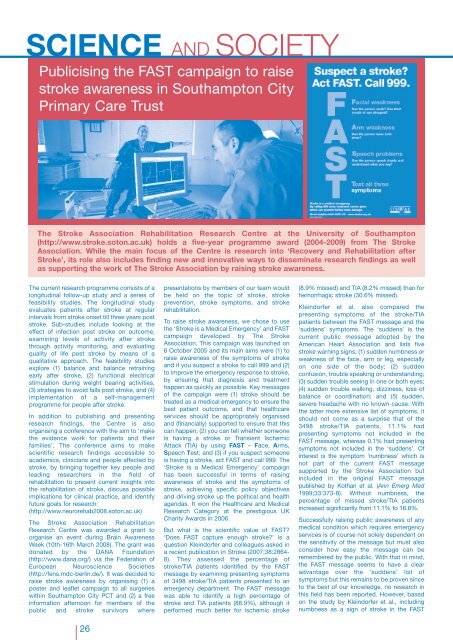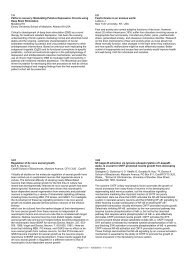Thalamostriatal projections revisited - British Neuroscience ...
Thalamostriatal projections revisited - British Neuroscience ...
Thalamostriatal projections revisited - British Neuroscience ...
- No tags were found...
You also want an ePaper? Increase the reach of your titles
YUMPU automatically turns print PDFs into web optimized ePapers that Google loves.
SCIENCE AND SOCIETYPublicising the FAST campaign to raisestroke awareness in Southampton CityPrimary Care TrustThe Stroke Association Rehabilitation Research Centre at the University of Southampton(http://www.stroke.soton.ac.uk) holds a five-year programme award (2004-2009) from The StrokeAssociation. While the main focus of the Centre is research into ‘Recovery and Rehabilitation afterStroke’, its role also includes finding new and innovative ways to disseminate research findings as wellas supporting the work of The Stroke Association by raising stroke awareness.The current research programme consists of alongitudinal follow-up study and a series offeasibility studies. The longitudinal studyevaluates patients after stroke at regularintervals from stroke onset till three years poststroke. Sub-studies include looking at theeffect of infection post stroke on outcome,examining levels of activity after strokethrough activity monitoring, and evaluatingquality of life post stroke by means of aqualitative approach. The feasibility studiesexplore (1) balance and balance retrainingearly after stroke, (2) functional electricalstimulation during weight bearing activities,(3) strategies to avoid falls post stroke, and (4)implementation of a self-managementprogramme for people after stroke.In addition to publishing and presentingresearch findings, the Centre is alsoorganising a conference with the aim to ‘makethe evidence work for patients and theirfamilies’. The conference aims to makescientific research findings accessible toacademics, clinicians and people affected bystroke, by bringing together key people andleading researchers in the field ofrehabilitation to present current insights intothe rehabilitation of stroke, discuss possibleimplications for clinical practice, and identifyfuture goals for research:(http://www.neurorehab2008.soton.ac.uk)The Stroke Association RehabilitationResearch Centre was awarded a grant toorganise an event during Brain AwarenessWeek (10th-16th March 2008). The grant wasdonated by the DANA Foundation(http://www.dana.org/) via the Federation ofEuropean <strong>Neuroscience</strong> Societies(http://fens.mdc-berlin.de/). It was decided toraise stroke awareness by organising (1) aposter and leaflet campaign to all surgerieswithin Southampton City PCT and (2) a freeinformation afternoon for members of thepublic and stroke survivors where26presentations by members of our team wouldbe held on the topic of stroke, strokeprevention, stroke symptoms, and strokerehabilitation.To raise stroke awareness, we chose to usethe ‘Stroke is a Medical Emergency’ and FASTcampaign developed by The StrokeAssociation. This campaign was launched on6 October 2005 and its main aims were (1) toraise awareness of the symptoms of strokeand if you suspect a stroke to call 999 and (2)to improve the emergency response to stroke,by ensuring that diagnosis and treatmenthappen as quickly as possible. Key messagesof the campaign were (1) stroke should betreated as a medical emergency to ensure thebest patient outcome, and that healthcareservices should be appropriately organisedand (financially) supported to ensure that thiscan happen; (2) you can tell whether someoneis having a stroke or Transient IschemicAttack (TIA) by using FAST – Face, Arms,Speech Test; and (3) if you suspect someoneis having a stroke, act FAST and call 999. The‘Stroke is a Medical Emergency’ campaignhas been successful in terms of raisingawareness of stroke and the symptoms ofstroke, achieving specific policy objectivesand driving stroke up the political and healthagendas. It won the Healthcare and MedicalResearch Category at the prestigious UKCharity Awards in 2006.But what is the scientific value of FAST?‘Does FAST capture enough stroke?’ is aquestion Kleindorfer and colleagues asked ina recent publication in Stroke (2007;38:2864-8). They assessed the percentage ofstroke/TIA patients identified by the FASTmessage by examining presenting symptomsof 3498 stroke/TIA patients presented to anemergency department. The FAST messagewas able to identify a high percentage ofstroke and TIA patients (88.9%), although itperformed much better for ischemic stroke(8.9% missed) and TIA (8.2% missed) than forhemorrhagic stroke (30.6% missed).Kleindorfer et al. also compared thepresenting symptoms of the stroke/TIApatients between the FAST message and the‘suddens’ symptoms. The ‘suddens’ is thecurrent public message adopted by theAmerican Heart Association and lists fivestroke warning signs; (1) sudden numbness orweakness of the face, arm or leg, especiallyon one side of the body; (2) suddenconfusion, trouble speaking or understanding;(3) sudden trouble seeing in one or both eyes;(4) sudden trouble walking, dizziness, loss ofbalance or coordination; and (5) sudden,severe headache with no known cause. Withthe latter more extensive list of symptoms, itshould not come as a surprise that of the3498 stroke/TIA patients, 11.1% hadpresenting symptoms not included in theFAST message, whereas 0.1% had presentingsymptoms not included in the ‘suddens’. Ofinterest is the symptom ‘numbness’ which isnot part of the current FAST messagesupported by the Stroke Association butincluded in the original FAST messagepublished by Kothari et al. (Ann Emerg Med1999;33:373-8). Without numbness, thepercentage of missed stroke/TIA patientsincreased significantly from 11.1% to 16.8%.Successfully raising public awareness of anymedical condition which requires emergencyservices is of course not solely dependent onthe sensitivity of the message but must alsoconsider how easy the message can beremembered by the public. With that in mind,the FAST message seems to have a clearadvantage over the ‘suddens’ list ofsymptoms but this remains to be proven sinceto the best of our knowledge, no research inthis field has been reported. However, basedon the study by Kleindorfer et al., includingnumbness as a sign of stroke in the FAST
















